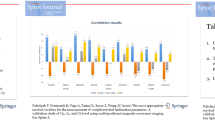Abstract
Purpose
To describe occipitocervical inclination (OCI), a new parameter that could compensate for defects in existing radiographic parameters, and to define occipitocervical neutral position.
Methods
Neutral, flexion, and extension lateral cervical spine radiographs of 200 patients (100 male and 100 female patients) judged to be normal were analyzed. The mean age was 45.19 years (range 11–74; 42.84 for male and 47.53 for female patients). For OCI, the angle formed by the line connecting the posterior border of the C4 vertebral body and McGregor’s line was measured. Occipitocervical angle (OCA) and occipitocervical distance (OCD) were measured and compared with OCI.
Results
OCI on standard, neutral lateral cervical radiographs was 102.51° ± 8.87°. There was no significant gender difference in neutral OCI 102.81° ± 7.93° for male and 102.21° ± 9.74° for female patients (P = 0.631). The mean neutral OCA was 38.69° ± 9.23°, and the mean neutral OCD was 22.98 ± 5.10 mm. Pearson’s correlation coefficient for the value of the cervical lordosis angle and that of neutral OCI was r = 0.274 (P < 0.001). Intraclass correlation coefficient values for inter- and intraobserver reliability for OCI were significantly higher than those for OCA (P < 0.001) and tended to be higher than those for OCD (P = 0.087).
Conclusions
OCI is a very useful parameter for the determination of neutral position during occipitocervical fusion for patients with altered C0–C2 anatomy.










Similar content being viewed by others
References
Wholey MH, Bruwer AJ, Baker HL Jr (1958) The lateral roentgenogram of the neck; with comments on the atlanto-odontoid-basion relationship. Radiology 71:350–356. doi:10.1148/71.3.350
Grob D (2000) Posterior occipitocervical fusion in rheumatoid arthritis and other instabilities. J Orthop Sci 5:82–87
Tan J, Liao G, Liu S (2014) Evaluation of occipitocervical neutral position using lateral radiographs. J Orthop Surg Res 9:87. doi:10.1186/s13018-014-0087-2
Amabile C, Le Huec JC, Skalli W (2016) Invariance of head-pelvis alignment and compensatory mechanisms for asymptomatic adults older than 49 years. Eur Spine J. doi:10.1007/s00586-016-4830-8
Maulucci CM, Ghobrial GM, Sharan AD, Harrop JS, Jallo JI, Vaccaro AR, Prasad SK (2014) Correlation of posterior occipitocervical angle and surgical outcomes for occipitocervical fusion. Evid Based Spine Care J 5:163–165. doi:10.1055/s-0034-1386756
Nunez-Pereira S, Hitzl W, Bullmann V, Meier O, Koller H (2015) Sagittal balance of the cervical spine: an analysis of occipitocervical and spinopelvic interdependence, with C-7 slope as a marker of cervical and spinopelvic alignment. J Neurosurg Spine 23:16–23. doi:10.3171/2014.11.spine14368
Protopsaltis TS, Scheer JK, Terran JS, Smith JS, Hamilton DK, Kim HJ, Mundis GM Jr, Hart RA, McCarthy IM, Klineberg E, Lafage V, Bess S, Schwab F, Shaffrey CI, Ames CP (2015) How the neck affects the back: changes in regional cervical sagittal alignment correlate to HRQOL improvement in adult thoracolumbar deformity patients at 2-year follow-up. J Neurosurg Spine 23:153–158. doi:10.3171/2014.11.spine1441
Phillips FM, Phillips CS, Wetzel FT, Gelinas C (1999) Occipitocervical neutral position. Possible surgical implications. Spine (Phila Pa 1976) 24:775–778
Izeki M, Neo M, Takemoto M, Fujibayashi S, Ito H, Nagai K, Matsuda S (2014) The O-C2 angle established at occipito-cervical fusion dictates the patient’s destiny in terms of postoperative dyspnea and/or dysphagia. Eur Spine J 23:328–336. doi:10.1007/s00586-013-2963-6
Miyata M, Neo M, Fujibayashi S, Ito H, Takemoto M, Nakamura T (2009) O-C2 angle as a predictor of dyspnea and/or dysphagia after occipitocervical fusion. Spine (Phila Pa 1976) 34:184–188. doi:10.1097/BRS.0b013e31818ff64e
Riel RU, Lee MC, Kirkpatrick JS (2010) Measurement of a posterior occipitocervical fusion angle. J Spinal Disord Tech 23:27–29. doi:10.1097/BSD.0b013e318198164b
Author information
Authors and Affiliations
Corresponding author
Ethics declarations
Conflict of interest
All authors have certified that they have no commercial associations (e.g., consultancies, stock ownership, equity interest, patent/licensing arrangements, etc.) that might pose a conflict of interest in connection with this article.
Rights and permissions
About this article
Cite this article
Yoon, SD., Lee, CH., Lee, J. et al. Occipitocervical inclination: new radiographic parameter of neutral occipitocervical position. Eur Spine J 26, 2297–2302 (2017). https://doi.org/10.1007/s00586-017-5161-0
Received:
Revised:
Accepted:
Published:
Issue Date:
DOI: https://doi.org/10.1007/s00586-017-5161-0




